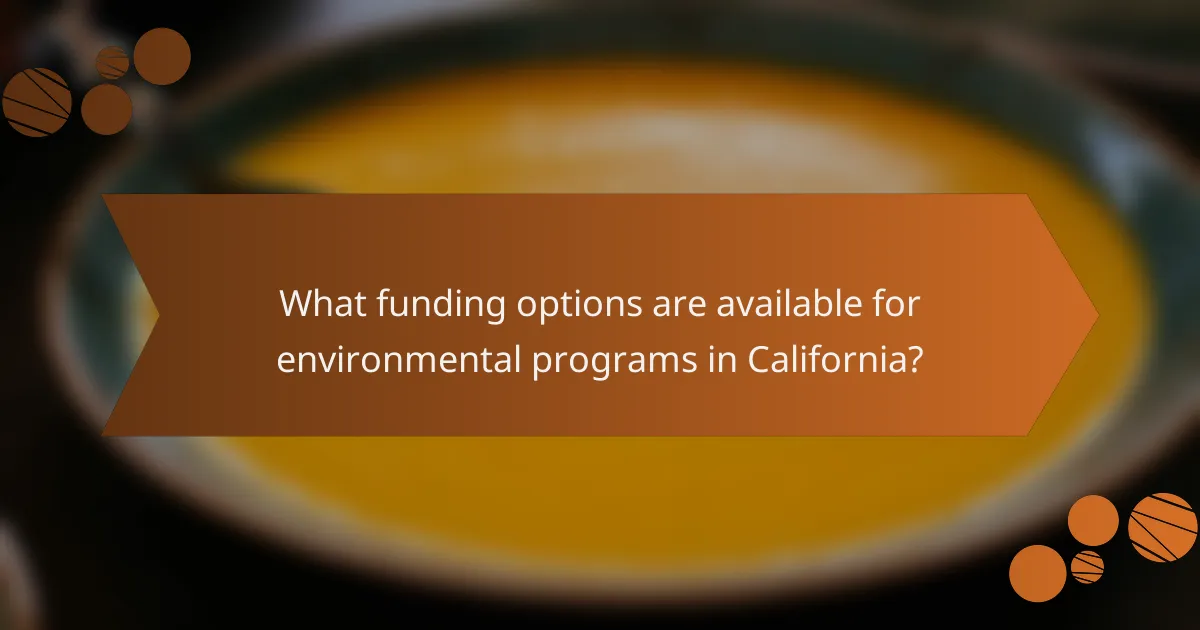Community environmental programs play a vital role in promoting sustainability and addressing local environmental challenges. Effective budgeting requires careful consideration of initial setup costs, ongoing maintenance, and funding for community engagement. Various funding options, including state and federal grants, local government allocations, and nonprofit partnerships, are available to support these initiatives and ensure their long-term success.

What are the cost considerations for community environmental programs in Los Angeles?
Cost considerations for community environmental programs in Los Angeles include initial setup costs, ongoing maintenance expenses, and funding allocation for community engagement. Understanding these factors is crucial for effective budgeting and program sustainability.
Initial setup costs
Initial setup costs for community environmental programs can vary significantly based on the project’s scope and scale. For instance, establishing a community garden may require several hundred to a few thousand dollars for land preparation, seeds, and tools.
Other projects, such as installing solar panels or creating a recycling program, can demand tens of thousands of dollars, depending on the technology and infrastructure needed. It’s essential to conduct a thorough cost analysis before launching any initiative.
Ongoing maintenance expenses
Ongoing maintenance expenses are a critical aspect of sustaining community environmental programs. These costs can include regular upkeep, utilities, and staff salaries, which may range from hundreds to thousands of dollars annually.
For example, maintaining a community park may involve landscaping, waste management, and event coordination, requiring a consistent budget allocation. Programs should anticipate these recurring costs to ensure long-term viability.
Funding allocation for community engagement
Funding allocation for community engagement is vital to the success of environmental programs. Engaging the community often requires resources for outreach, educational materials, and events, which can account for a significant portion of the budget.
Allocating around 10-20% of the total program budget for community engagement activities can enhance participation and support. It’s important to seek diverse funding sources, including grants, donations, and local partnerships, to cover these costs effectively.

What funding options are available for environmental programs in California?
California offers a variety of funding options for environmental programs, including state grants, federal funding, and local government budget allocations. These resources can help communities implement sustainability initiatives and address environmental challenges effectively.
State grants for sustainability projects
California provides numerous state grants aimed at promoting sustainability projects. These grants are often administered through agencies like the California Environmental Protection Agency and the California Energy Commission. They can cover a range of initiatives, from renewable energy installations to water conservation efforts.
To apply for state grants, organizations typically need to demonstrate how their projects align with state environmental goals. It’s crucial to prepare a detailed proposal that outlines the project’s objectives, expected outcomes, and budget. Common pitfalls include underestimating project costs and failing to meet application deadlines.
Federal funding through the EPA
The U.S. Environmental Protection Agency (EPA) offers federal funding opportunities for environmental programs in California. These funds can support projects related to air quality, water quality, and waste management. Programs like the Clean Water State Revolving Fund and the Brownfields Program are examples of federal initiatives that provide financial assistance.
Organizations seeking EPA funding must adhere to specific guidelines and reporting requirements. It’s advisable to stay informed about application cycles and eligibility criteria. Engaging with local EPA representatives can also provide valuable insights and enhance the chances of securing funding.
Local government budget allocations
Local governments in California often allocate budget funds for environmental programs, reflecting community priorities and needs. These allocations can support various initiatives, such as urban greening, waste reduction, and public transportation improvements. The amount available varies significantly by municipality and is influenced by local tax revenues and policy decisions.
To access local funding, community organizations should engage with city councils or county boards to advocate for environmental initiatives. Building partnerships with local government can also enhance project visibility and increase the likelihood of receiving funding. It’s essential to understand the local budget cycle and prepare proposals that align with community goals.

How can nonprofits secure funding for environmental initiatives?
Nonprofits can secure funding for environmental initiatives through various channels, including grants, partnerships, and crowdfunding. Each method has its own advantages and considerations, making it essential for organizations to evaluate which options align best with their goals and resources.
Grant writing best practices
Effective grant writing is crucial for nonprofits seeking funding for environmental projects. Start by thoroughly researching potential grant opportunities that align with your mission and project goals. Tailor your proposal to meet the specific requirements of each grant, clearly outlining your objectives, expected outcomes, and budget.
Use clear and concise language, and include data or case studies to support your claims. Highlight community impact and sustainability to make your proposal more compelling. Remember to follow all formatting and submission guidelines to avoid disqualification.
Partnerships with local businesses
Forming partnerships with local businesses can provide nonprofits with additional funding and resources for environmental initiatives. Businesses often seek to enhance their corporate social responsibility (CSR) profiles and may be willing to sponsor projects or provide in-kind donations.
To establish successful partnerships, identify businesses that share similar values and missions. Propose mutually beneficial projects that can enhance their visibility while contributing to community sustainability. Regular communication and updates on project progress can help maintain these relationships over time.
Crowdfunding strategies
Crowdfunding is an increasingly popular method for nonprofits to raise funds for environmental initiatives. Platforms like GoFundMe or Kickstarter allow organizations to present their projects to a wider audience and collect small contributions from many individuals.
To maximize success, create a compelling campaign that includes engaging visuals and a clear narrative about your project’s impact. Set realistic funding goals and offer incentives for different contribution levels. Promote your campaign through social media and community events to reach potential supporters effectively.

What are the benefits of community involvement in environmental programs?
Community involvement in environmental programs leads to numerous benefits, including heightened awareness of environmental issues and increased participation in sustainability efforts. Engaging local residents fosters a collective responsibility towards environmental stewardship, ultimately resulting in healthier communities.
Enhanced public awareness
When communities participate in environmental programs, public awareness of local and global environmental issues significantly improves. Educational initiatives, workshops, and community events inform residents about topics such as recycling, conservation, and pollution prevention.
For example, a community clean-up event can highlight the impact of litter on local wildlife, prompting residents to adopt more sustainable practices. Increased awareness often translates to more informed citizens who advocate for environmentally friendly policies.
Increased volunteer participation
Community involvement typically leads to higher volunteer participation in environmental initiatives. When individuals see their neighbors actively engaged, they are more likely to join in, creating a culture of volunteerism.
Programs that offer flexible volunteering options, such as weekend clean-ups or educational workshops, can attract a wider range of participants. This collective effort not only enhances the program’s impact but also builds a sense of ownership among volunteers.
Stronger community ties
Participating in environmental programs fosters stronger ties among community members. Working together towards a common goal helps build relationships and trust, which are essential for a cohesive community.
For instance, community gardens not only promote sustainability but also serve as social hubs where residents can connect, share resources, and support each other. These strengthened ties can lead to broader community engagement in various local issues beyond environmental concerns.

What are the prerequisites for starting an environmental program?
Starting an environmental program requires a clear understanding of community needs, compliance with regulations, and effective stakeholder engagement. These prerequisites ensure that the program is relevant, legally sound, and supported by those it aims to benefit.
Community needs assessment
A community needs assessment identifies the specific environmental issues that affect a locality. This process typically involves surveys, public meetings, and data analysis to gather input from residents and stakeholders.
Consider focusing on prevalent concerns such as waste management, air quality, or water conservation. Engaging with the community through workshops can help prioritize these needs and tailor the program accordingly.
Regulatory compliance requirements
Understanding regulatory compliance is crucial for any environmental program. This includes familiarizing yourself with local, state, and federal laws that govern environmental practices.
Common regulations may involve waste disposal standards, emissions limits, and water quality guidelines. Consulting with legal experts or local environmental agencies can help ensure that your program adheres to these requirements and avoids potential fines.
Stakeholder engagement strategies
Effective stakeholder engagement is vital for the success of an environmental program. This involves identifying key stakeholders such as local government, businesses, and community groups, and developing strategies to involve them in the program’s planning and implementation.
Consider using tools like surveys, focus groups, and public forums to gather feedback and foster collaboration. Building strong relationships with stakeholders can enhance support and increase the program’s impact.

How do environmental programs impact local economies?
Environmental programs can significantly enhance local economies by fostering sustainable practices and creating new opportunities. These initiatives often lead to job creation and increased property values, which contribute to overall economic growth.
Job creation in green sectors
Environmental programs often stimulate job creation in sectors focused on sustainability, such as renewable energy, waste management, and conservation. For instance, investments in solar or wind energy can generate numerous jobs, from manufacturing to installation and maintenance.
Additionally, local governments may offer incentives for businesses that adopt eco-friendly practices, further encouraging job growth. Communities can expect to see a rise in employment opportunities, particularly in areas with a strong focus on environmental initiatives.
Increased property values
Implementing environmental programs can lead to increased property values as neighborhoods become more attractive due to improved green spaces and reduced pollution. Properties located near parks, greenways, or energy-efficient developments often see a rise in demand, driving up prices.
Moreover, homes in areas with robust environmental regulations may benefit from lower utility costs and a healthier living environment, making them more desirable. This trend can result in a positive feedback loop, where increased property values further fund local environmental initiatives.
